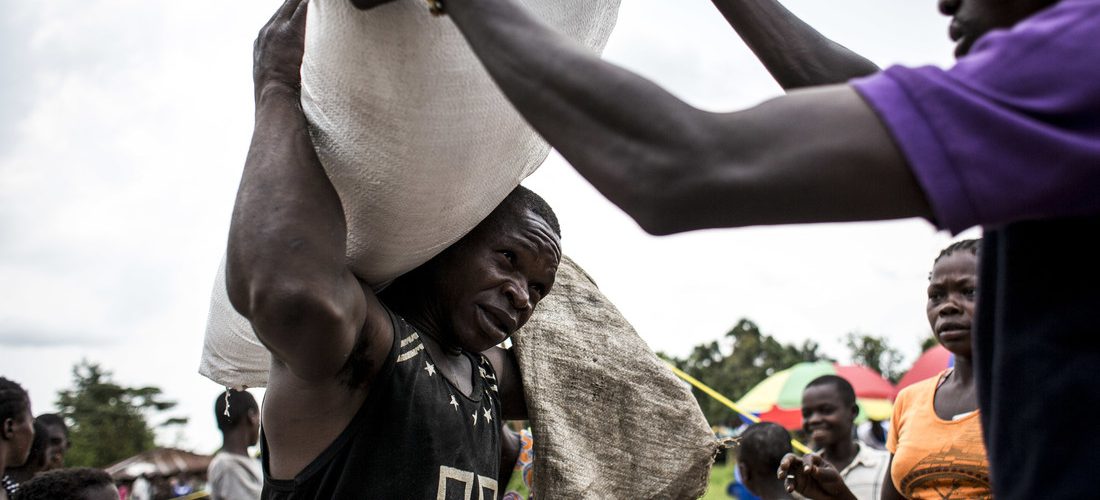Millions of people facing severe hunger and acute malnutrition in one of the worst hit areas of the Democratic Republic of Congo (DRC) risk having life-saving aid cut if donors do not plug a hole in the aid budget, Oxfam warned today.
By the start of 2018, the United Nations estimates that 13 million people in the DRC will need emergency aid and protection from conflict, equivalent to more than half the population of Australia.
Tens of thousands of people have already had their food rations cut and Oxfam’s aid work in the Kasai region, which aims to help 180,000 people, may have to close when funding runs out in March 2018.
Jose García Barahona, Oxfam’s Country Director for the DRC, said:
“Vicious conflict has left millions of people in Kasai severely hungry and the world cannot continue to ignore this scale of human suffering. Terrorised and traumatised, over one and a half million people have fled their homes and land in search of safety. Now that we can reach more of those affected, we must help them with the food and other aid they desperately need until they can return home and replant their crops.
“Governments and international donors need to urgently plug the funding gap as without sufficient aid we will not be able to support the millions of people who need it today in Kasai and in the rest of Congo. It is critical that we act now to bring communities together and help rebuild their lives.”
Conflict broke out in previously peaceful Kasai last year and Oxfam has received eye-witness accounts of rape, mutilations, mass killings, and beheadings, including brutal attacks and murders of very young children.
The conflict has led to an eight-fold increase in hunger. Over three million people are going hungry, but Oxfam and the UN have had to resort to halving emergency food rations due to the funding shortfalls.
Three full farming seasons have been missed, leading to severe food shortages. Many families are forced to survive on just one meal a day, on a diet mainly of maize and cassava, without access to more nutritious food. While 400 000 children are reported to be severely malnourished in the Greater Kasai region, further delay in delivering aid will lead to higher levels of mortality and serious stunting.
Millions of people still do not have access to clean water, drinking instead from unprotected water sources. Oxfam has brought in equipment to start drilling boreholes to provide handpumps or piped water. However, it is a race against time as funding ends in February and the current rainy season increases the risk of cholera and other water-borne diseases.
At the height of the conflict, entire villages were torched. As the security situation improves, some people have returned to their homes to find they have been destroyed by the militias and all their goods stolen. Those who fled to the bush or sought shelter in churches or other villages put further strain on already scarce food and other resources.
International agencies have appealed to donors to increase their contributions as according to the UN, the cost of delivering aid in DRC in 2018 will double to $1.7 billion, from $812 million this year. So far, the UN has received a fraction of that – at $456 million.
For interviews or more information, please contact Dylan Quinnell on 0450 668 350 or dylanq@oxfam.org.au
Donations to support Oxfam’s emergency responses in the DR Congo and around the world can be made at www.oxfam.org.au/icf
Notes for Editors
- Photographs of food distributions and testimonies from people interviewed by Oxfam in Kasai are available on this link (Names of eye witnesses have been changed to protect identity).
- 2 million people need urgent food assistance in Kasai, according to World Food Programme data.
- The UN-led 2017 Humanitarian Response Plan for DRC received only $456.7 million of the $812 million needed.
- UNOCHA view of the scale of the crisis in DRC and Kasai, mentioning the eight-fold increase in acute hunger.
- Briefing on DRC from Mark Lowcock, United Nations Under-Secretary-General for Humanitarian Affairs and Emergency Relief Coordinator and the Head of the United Nations Office for the Coordination of Humanitarian Affairs, in which he explains the extent of underfunding and consequences.
- For details of how you can donate to Oxfam’s emergency response.
- The conflict in Kasai started in August 2016 after a dispute between the government and the local community as to who should be the next tribal leader. The crisis has now spread to five provinces of Kasai and has led to infighting between different armed groups, with much of the extreme violence directed against ordinary civilians.
- Oxfam’s programme in Kasai has helped 50,000 people so far, but intends to reach a total of 180,000 people forced to flee, providing food, water and sanitation, essential household non-food items (eg. water containers, soap, cloth, clothing, personal hygiene kits, and basic kitchenware) and helping to keep people safe.


Comments are closed.